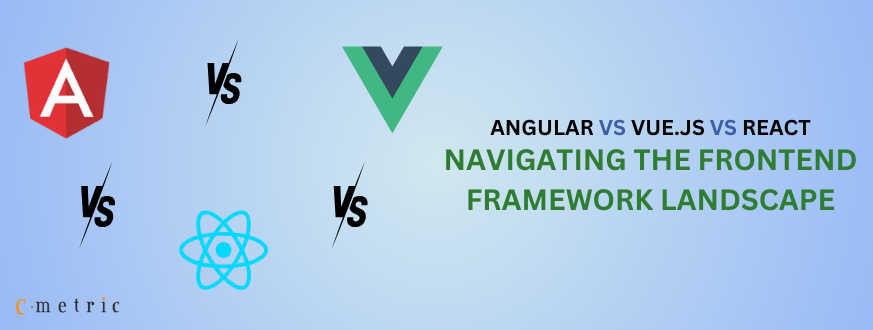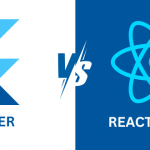Frontend development has seen a revolutionary shift, with the introduction of Angular vs Vue.js vs React, they are beginning to compete to become the most popular frontend frameworks. Selecting the best development feature is challenging but crucial for companies and developers alike because each one has unique advantages, benefits, and community support of its own.
Recognizing React
React, which was created by Facebook, is well-known for its virtual DOM concept and JSX syntax. Its component-based architecture enables programmers to design scalable and efficient user interfaces. React has gained immense popularity in the industry due to its flexibility and ability to handle complex states.
Unveiling Angular
Renowned for its two-way data binding and Angular CLI, Angular is a framework packed with capabilities, and supported by Google. The framework includes dependency injection to facilitate the writing of more modular and maintainable code. Angular is often utilized for large-scale enterprise applications due to its robust features and TypeScript integration.
Exploring Vue.js
Despite being a more recent framework than Angular and React, Vue.js has been accepted by a larger segment for its ease of use and simple integration systems. Vue’s component-based architecture and reactive data binding make it an excellent choice for both small and large applications. The comprehensive documentation and easy learning curve of Vue.js are well known.
Comparing Angular vs Vue.js vs React
Differences between React and Angular:
What sets Angular apart from React:
- Angular is a feature-rich web application development framework developed and maintained by Google.
- However, Facebook created the JavaScript library React primarily for the purpose of creating user interfaces. In terms of project organization and integration with other frameworks and libraries, it offers more flexibility.
Syntax Variations:
- TypeScript, an enhanced version of JavaScript that provides additional tool support for larger projects in addition to static typing, is used by Angular.
- With the help of the syntactic extension JSX, programmers can build JavaScript code that resembles HTML. This is how React provides a more component-centric method of developing user interfaces.
Data Binding Techniques:
- Two-way data binding is used by Angular, where changes made to the model state instantly update the view and vice versa. This bidirectional data flow facilitates progress, but it may also cause complex systems to behave differently.
- Since React employs a unidirectional data flow paradigm, information can travel in just one path from parent to child components, making it easier to control data flow and reason about the application’s current state.
Component-based Architecture Comparison:
- Component-based Architecture Comparison: The component-based architecture used by React and AngularJS allows developers to create encapsulated and reusable user interface components. This is where the two frameworks diverge.
- likewise, Vue.js’s component-based architecture, which divides concerns, encourages code reusability and ease of maintenance.
Node JS Vs Angular JS – An in-Depth Comparison
React vs Angular:
- React prioritizes flexibility and performance, allowing developers to choose the frameworks and tools that best suit their projects’ requirements.
- js emphasizes simplicity and ease of integration, making it a perfect choice for smaller apps and rapid prototyping, even though it offers a comparable degree of capability.
Vue vs React JS:
- Vue vs. React JS: Given its simpler syntax and more forgiving learning curve than React, Vue.js is more accessible to developers of all experience levels.
- Its virtual DOM implementation and component-based design are similar to React’s.
React vs Vue:
- React places a high value on performance and flexibility, letting developers select the libraries and tools that best meet the needs of their projects.
- While providing a comparable level of functionality, Vue.js strongly emphasizes simplicity and ease of integration, making it a great option for smaller applications and quick prototyping.
Our another piece of content
React Native vs Ionic: The Best Mobile App Framework in 2024
Angular vs Vue:
- Angular is favored due to its robust capabilities and wide range of tools, which suit it well for enterprise-scale projects that demand collaboration and exacting development guidelines.
- Startups and smaller projects searching for a flexible and lightweight framework usually select Vue.js due to its user-friendly API and low learning curve.
Performance Comparison: Angular vs Vue.js vs React
Performance is an essential part of front-end development. React’s virtual DOM maximizes rendering efficiency, Angular’s two-way data binding can impact speed, and Vue.js strikes a balance between simplicity and performance. One of the things that can have a big impact on how well your application performs overall is bundle size.
1. Ecosystem and Community Support
The most valuable aspects of a framework are its ecology and community. React has a vast library of third-party frameworks, Angular has strong enterprise support, and Vue.js is flourishing due to its active and growing community. Industry changes and adoption rates play a major role in determining how sustainable a framework is.
2. Learning Curve
For developers, ease of use is crucial in a framework. React’s ease of use, Angular’s wealth of documentation, and Vue.js’s short learning curve make them accessible to developers of all skill levels. When choosing a framework, consider the support provided for beginners.
3. Flexibility and Scalability
It’s critical that a framework be able to adapt to evolving project requirements. Vue.js is a middle ground between the very flexible React framework and the hierarchical architecture of Angular. Consider the scalability of each framework in view of the project’s projected growth.
4. Tooling and Development Experience
Developer tools, choices for continuous integration, and debugging tools improve the development process as a whole. React, Angular, and Vue.js each offer a set of features, extensions, and tools for debugging. Look at the tools that meet the requirements of the project and your process.
Industry Use Cases
Real-world applications showcase the strengths of each framework. React is prevalent in social media and e-commerce platforms, Angular dominates in enterprise-level applications, and Vue.js is often chosen for rapid prototyping and smaller projects. Consider industry use cases to align your choice with project needs.
Updates and Maintenance
Frameworks evolve over time, therefore keeping them updated is critical to the success of projects over the long term. React, Angular, and Vue.js have different long-term support considerations and update rates. Consider the impact that version upgrades have on active projects and choose a framework that works well with your maintenance schedule.
Future Outlook
When predicting the future of frontend frameworks, it is important to consider the past of React, Vue.js, and Angular. Industry projections, community-driven innovations, and future-focused features provide insightful information. Choose a framework that provides a high likelihood of project success in the long run.
Conclusion
In the Angular vs. Vue.js vs. React duel, the ideal choice is dependent upon several factors. Consider the project’s long-term goals, team makeup, scope, and level of difficulty. React is renowned for its adaptability, Vue.js for its ease of use and versatility, and Angular for its durability in applications intended for business use. Ultimately, the decision is made based on individual tastes and project requirements. Contact Us today to get the best for your business.
Frequently Asked Questions (FAQs)
1. What is the main difference in Angular vs Vue.js vs React?
Each framework has its own syntax, data binding methods, and philosophy. Vue.js employs templates, Angular uses TypeScript, and React uses JSX.
2. Which framework is more effective when used for smaller projects?
Vue.js is a popular option for small projects due to its simplicity and ease of integration.
3. What part in these frameworks does state management play?
React offers a unidirectional data flow, Angular employs bidirectional data binding, and Vue.js use reactive data binding to control state.
4. Can I use multiple frameworks in a single project?
While not recommended, it’s technically possible to use multiple frameworks in a project. However, this can lead to complexity and maintenance challenges.















Get in Touch